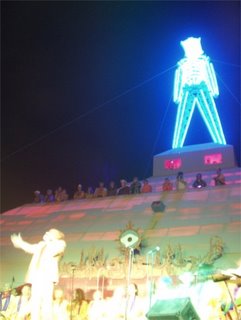
Simeon Payne, one of the members of the
Lausanne issue group on postmodern and alternative spiritualities that I am a part of, passed along a copy of some data on "The Religious and Spiritual Lives of Teenagers," from a publication out of Australia,
Pointers Vo. 16, No. 1 (March 2006). The publication is produced by the
Christian Research Assocation and I have found previous issues of this publication helpful in assessing Australia's spiritual climate in contrast to America's.
The subject of this issue of
Pointers is of particular interest to me in that I am intrigued by youth alternative subcultures and spiritualities, such as Goths, Raves, and to a certain extent we could include Burning Man there as well.
The article on teen spirituality takes a book by Christian Smith as its point of departure. In 2005 he published
Soul Searching: The Religious and Spiritual Lives of American Teenagers (Oxford University Press), which caused spawned a debate in the United States. The Christian Research Association is building on the research from this book through their Australian 'Spirit of Generation Y' study. The result is an interesting contrast of teen spirituality among young people in Australia and the United States.
The article mentions that "Australians are considerably more likely to believe in reincarnation, astrology, the possibility of communication with the dead and the powers of psychics and fortune-tellers than are US young people."
The article also noted that American teens are more likely than their Australian counterparts to have some connection or involvement to a church, particularly a Protestant or evangelical group, and that there is a correlation for these teens who show less interest in alternative forms of spiritual exploration.
Yet even though American teens are more active in church than those in Australia, the article states that, "The spiritual dimensions of life are close to the bottom of the list in terms of what they really consider important." Christian Smith states in his book that for American teens religion is "somewhere in the background" rather than the forefront of their lives:
The majority of US teenagers are not rebellious toward religion but are generally rather positive about and conventional in living out religion. This fact should not, however, be presumed to mean that religion is among the most important concerns in the majority of US teenagers' everyday lives. ... However generally positive teens may feel about religion, when it comes to getting specific about religion in their lives, most teens seem simply to accept religion as a taken-for-granted aspect or presence that most operates in the background of their lives.
Like their parents and other adults in the U.S. and Australia, teens pursue a consumerist approach to religion where the individual picks and chooses what is useful in personal application. This consumerist framework led Smith to state that:
For most US teenagers, religion is something to personally believe in that makes one feel good and resolves one's problems. For most, it is not an entire way of life or a disciplined practice that makes hard demands or changes people. Stated differently, for many US teenagers, God is treated as something like a cosmic therapist or counselor, a ready and competent helper who responds in times of trouble but who does not particularly ask for devotion or obedience. ... Thus, one 14 year-old white Catholic boy from Ohio told us, "Faith is very imortant, I pray to God to help me with sports and school and stuff and he hasn't let me down yet, so I think it helps you."
Several things should be reflected on as a result of this study by parents and youth pastors in America:
1. While American teens demonstrate greater involvement in Christian church's than their Australian counterparts, this trend could change as the country continues its journey in post-Christendom culture.
2. The result of secularization in the West has been a spiritual re-enchantment process involving an interest in alternative spiritualities and a declining interest in Christianity. While the situation is far more advanced in the United Kingdom and Australia, the social and cultural process of re-enchantment and post-Christendom is moving across the Western world and unless our changing social circumstances are recognized and engaged with appropriately, in the future we may see statistics about teen spirituality in the U.S. that more closely resemble those of other Western countries.
3. Related to number 2, we might recall George Barna's
survey which stated that "twentysomethings" who had previously been active in church life during their teen years are tending to leave the church as they enter their twenties.
4. Although American teens are more active in churches and Christian spirituality than are Australians, this has not made Christian spirituality a priority of life, nor does not seem to have made an impact in how teens live their lives.
5. We might also consider the importance of the media as to how it shapes the spiritual lives and understandings of teens. Related to this Lynn Schofield Clark has an interesting book that parents and youth pastors should consider reading titled
From Angels to Aliens: Teenagers, the Media and the Supernatural (Oxford University Press, 2003).
If our young people really are the priority that churches say they are in programs, buildings, and funding, then we have our work cut out of us in making the Christian faith are more foundational and meaningful aspect of the lives of young people. It seems clear that something new needs to be done.












